Kia Stinger: Emergency Call System / Emergency Call (eCall) Unit
Components and components location
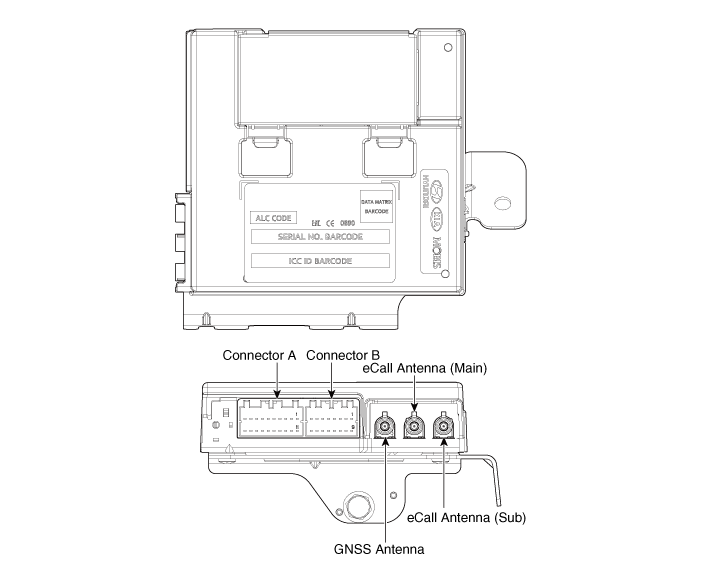
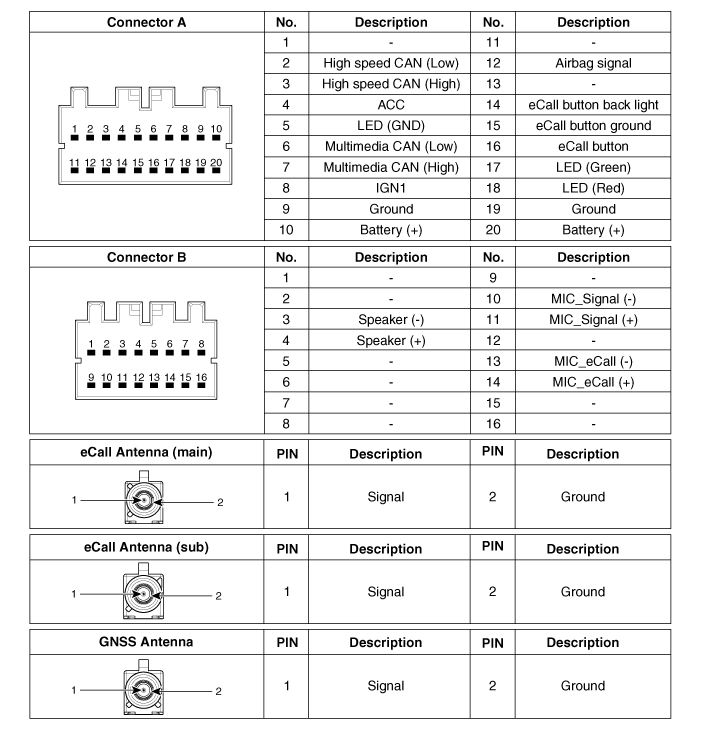
|
The eCall unit for AVN is equipped in AVN head unit.
|
Repair procedures
|
Carry out the Test Mode after:
| – |
Replacing the eCall unit
|
| – |
Replacing the Back-up Battery (BUB)
|
| – |
Replacing the eCall speaker and MIC
|
| – |
Replacing the eCall antenna and roof antenna
|
|
| • |
Be careful not to scratch the cluster fascia panel and related
parts.
|
| • |
When removing with a flat-tip screwdriver or remover, wrap protective
tape around the tools to prevent damage to components.
|
| • |
Carefully store and handle the crash pad when removing/installing
as lubricant and oil can leave a stain on the trim.
|
|
eCall Unit
| 1. |
Disconnect the negative (-) battery terminal.
|
| 2. |
Remove the glove box housing.
(Refer to Body - "Glove Box Housing")
|
| 3. |
Disconnect the eCall unit connectors (A).
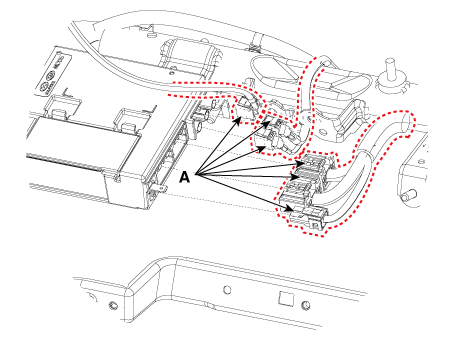
|
| 4. |
Remove the eCall unit (A) after loosening the mounting screw and nuts.
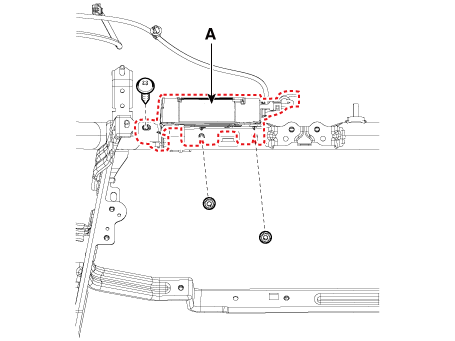
|
eCall Antenna
| 1. |
Disconnect the negative (-) battery terminal.
|
| 2. |
Remove the main crash pad assembly.
(Reafer to Body - "Main Crash Pad Assembly")
|
| 3. |
Remove the eCall antenna (A) after loosening the mounting screws and
disconnecting the connector (B).
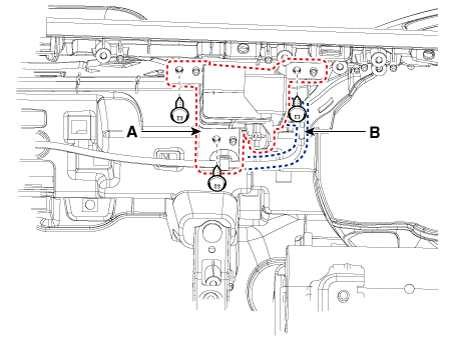
|
eCall Speaker
| 1. |
Disconnect the negative (-) battery terminal.
|
| 2. |
Remove the center speaker grill (A) by using a remover.
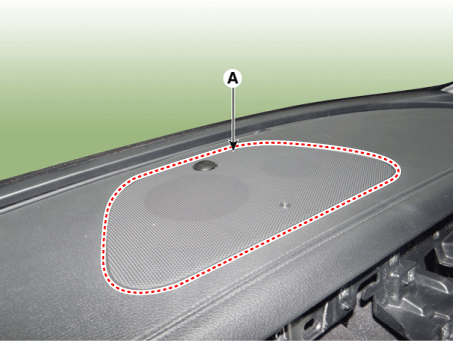
|
| 3. |
Disconnect the security connector (A) and auto light sensor & photo sensor
connector (B).
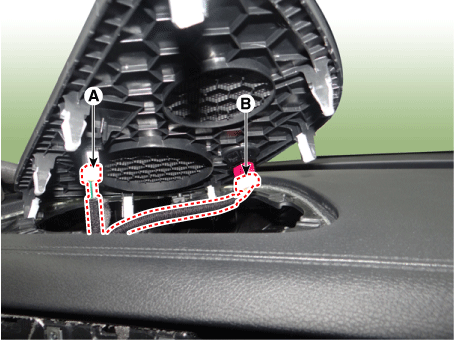
|
| 4. |
Remove the eCall speaker (A) after loosening the mounting screws.
|
| 5. |
Disconnect the eCall speaker connector (B).
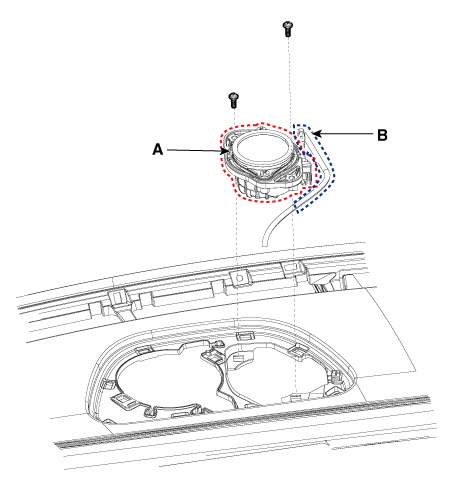
|
eCall Unit Back Up
Battery (BUB)
| 1. |
Disconnect the negative (-) battery terminal.
|
| 2. |
Remove the eCall Unit.
|
| 3. |
To replace the back-up battery, remove it after removing the back-up
battery cover (A).
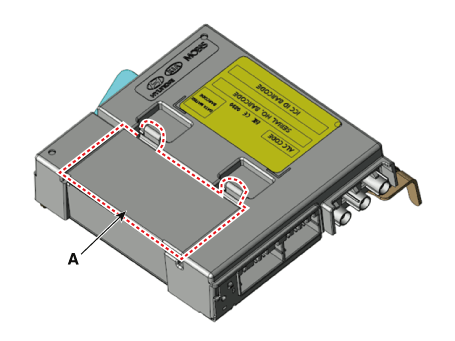
|
|
Carry out the Test Mode in the following cases.
| – |
Replacing the eCall unit
|
| – |
Replacing the Back-up Battery (BUB)
|
| – |
Replacing the eCall speaker and MIC
|
| – |
Replacing the eCall antenna and roof antenna
|
|
eCall Unit
| 1. |
Install the eCall unit.
|
| 2. |
Connect the eCall unit connectors.
|
| 3. |
Install the glove box housing.
|
| 4. |
Connect the negative (-) battery terminal.
|
eCall Antenna
| 1. |
Install the eCall antenna.
|
| 2. |
Connect the eCall antenna connector.
|
| 3. |
Install the main crash pad assembly.
|
| 4. |
Connect the negative (-) battery terminal.
|
eCall Speaker
| 1. |
Connect the eCall speaker connector.
|
| 2. |
Install the eCall speaker.
|
| 3. |
Connect the security connector and auto light sensor & photo sensor connector.
|
| 4. |
Install the center speaker grill.
|
| 5. |
Connect the negative (-) battery terminal.
|
Inspection (With KDS)
| 1. |
In the body electrical system, failure can be quickly diagnosed by using
the vehicle diagnostic system (KDS).
The diagnostic system (KDS) provides the following information.
| (1) |
Self diagnosis : Checks failure and code number (DTC)
|
| (2) |
Current data : Checks the system input/output data state
|
| (3) |
Actuation test : Checks the system operating condition
|
| (4) |
Additional function : Controls other features including system
option setting and zero point adjustment
|
|
| 2. |
Select the 'Car model' and the 'Telematics System' to be checked in order
to check the vehicle with the tester.
|
| 3. |
Select the 'Current Data' menu to check the current state of the input/output
data.
|
eCall Test Mode
Press the SOS TEST button to activate the audio guidance and test the eCall system
according to the guidance.
In the Test Call stage, which is the last stage of the test mode, press the SOS
button according to the audio guidance to send the data on faulty components to
the call center.
To stop the test mode, press the SOS TEST button again during the audio guidance.
| 1. |
Conditions for the test mode operation:
| (1) |
Vehicle battery is connected properly.
|
| (2) |
One minute has passed after ignition.
|
| (3) |
The vehicle remains stationary for 1 minute or more.
|
|
| 2. |
Conditions preventing the test mode operation:
| (1) |
A call is made to a PSAP.
|
| (2) |
Call Back mode : The eCall system enters the Call Back mode after
a successful call and is in standby for 120 minutes to receive calls
from the call center.
|
| (3) |
The test mode automatically ends when the vehicle speed is 1
km/h or above or has moved 300 m or more.
|
| (4) |
Two minutes have not passed after the previous test call ended.
|
|
| 3. |
Operation sequence of the test mode (audio guidance):
| (4) |
BUB (Back-up battery embedded in the eCall unit) test (no separate
notification is provided if the BUB is in normal condition.)
|
• |
Backup battery audio prompt guide
If the audio guidance notifies that "The voltage
of Backup battery is low to make emergency call",
retry test mode after sufficiently charging the
battery by driving.
|
|
|
| (5) |
Test call (Pressing the SOS button sends the test result to a
PSAP.)
|
|
|
The red LED stays turned on if one or more DTCs for the eCall system
are issued.
If the red LED is on, be sure to use the diagnostic tool (KDS/GDS) to
check for any failure.
|
Inspecting Back-up
Battery
Back-up battery (BUB) embedded in the eCall system has a finite lifespan and
its charging/discharging performance may be diminished after an extensive use.
The back-up battery guarantees the operation of the eCall system when the vehicle
battery cannot be used due to an accident. Be sure to inspect the back-up battery
if the red LED turns on and replace it if necessary.
|
Warranty on Back-up Battery is 3 years.
Inspect the back-up battery every three years and replace it if necessary.
(Refer to Emergency Call Unit - "Repair Procedures")
|
|
The eCall system is aimed to place an urgent call to the call center
during an emergency. Arbitrarily removing or operating the system components
may affect the safety of people and may result in false notification of
an accident to the emergency call center.
|
Components and components location
Components
1. Head unit (AVN, Audio)
2. Emergency call button
3. Emergency call MIC
4. Roof antenna
5. Emergency call unit ...
Components and components location
Component
Repair procedures
Removal
1.
Disconnect the negative (-) battery terminal.
2.
Remove ...
Other information:
Repair procedures
Removal
•
Put on gloves to prevent hand injuries.
•
When removing with a flat-tip screwdriver or remover, wrap protective
t ...
Repair procedures
Refrigerant Recovery
When removing HFC-134a (R-134a) from the air conditioning system, use only U.L.-listed
service equipment certified to meet the requirements of SAE J2210.
•
...


 Emergency Call System
Emergency Call System Emergency Call (eCall) Button
Emergency Call (eCall) Button









